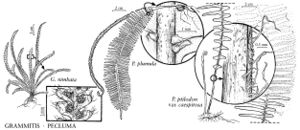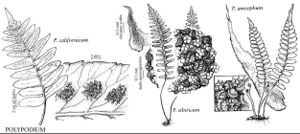Polypodiaceae
Plants perennial, terrestrial, on rock, or often epiphytic, erect, arching, or occasionally pendent. Stems long- to short-creeping, branched or not, bearing scales and few to numerous roots, usually dictyostelic. Leaves monomorphic to dimorphic, circinate in bud. Petiole usually articulate at base [rarely nonarticulate, as in Loxogramme], lacking scales or sometimes scaly, with usually 3 vascular bundles. Blade simple to often pinnatifid, pinnatisect, or pinnate, infrequently more divided; rachis grooved or not adaxially. Veins free (and simple to several times forked) to often anastomosing in complex systems, areoles with or without included veinlets. Indument on blade absent, or petiole, rachis, costae, and sometimes blade tissue usually bearing hairs (these often septate and with reddish crosswalls) and/or scales. Sori borne abaxially on veins, round to oblong, occasionally elongate, rarely marginal, rarely covering surface; paraphyses present or absent; sporangia with stalk of 2 or 3 rows of cells; indusia absent. Spores usually transparent or yellowish (rarely greenish), all 1 kind, bilateral, monolete [rarely trilete, as in some Loxogramme], surface most often smooth, tuberculate, verrucose, or granulate, occasionally spiny, 64 per sporangium (spores globose and 32 per sporangium in apogamous spp.). Gametophytes green, aboveground, cordate or elliptic, glabrous or sometimes glandular; archegonia and antheridia borne on lower surface, antheridia 3-celled.
Distribution
Worldwide, especially tropics and subtropics.
Discussion
Phymatosorus scolopendria (Burman f.) Pichi-Sermolli, native to the Old World, is a rare escape in southern Florida.
Genera in this family are variously circumscribed, and the New World species historically were placed in the single genus Polypodium. Many of the segregates recognized here are still placed in Polypodium in recent floristic accounts. Limits of genera in both Old World and New World are controversial and are currently under study by several workers.
(Key to genera of Polypodiaceae)
Genera ca. 40, species perhaps 500 (7 genera, 25 species in the flora).
Selected References
None.
Lower Taxa
Illustrations
Key
| 1 | Blades simple, undivided. | > 2 |
| 1 | Blades pinnatifid or pinnatisect, rarely 1-pinnate. | > 5 |
| 2 | Sporangia confined to marginal or nearly marginal bands in distal 1/2 of blade. | Neurodium |
| 2 | Sporangia in discrete, round to oblong or slightly elongate sori on abaxial surface, not in marginal bands. | > 3 |
| 3 | Blades abaxially with peltate scales. | Pleopeltis |
| 3 | Blades abaxially glabrous, except for scattered scales on midrib. | > 4 |
| 4 | Stems 2-10 mm diam.; sori in 1-10 or more rows between midrib and margin; petioles clustered, proximate; main lateral veins often prominent, ±parallel. | Campyloneurum |
| 4 | Stems 0.5-1.5 mm wide; sori in 1 row between midrib and margin; petioles well separated, often 1-2 cm apart; main lateral veins obscure, not parallel. | Microgramma |
| 5 | Blades with numerous peltate or ovate scales abaxially. | Pleopeltis |
| 5 | Blades lacking scales abaxially except along midrib. | > 6 |
| 6 | Blades pectinate, usually with more than (20-)25 pairs of segments; segments narrow, linear, 1.5-5(-8) mm wide; veins free; stems short-creeping; Florida. | Pecluma |
| 6 | Blades pinnatifid, rarely 1-pinnate, with fewer than 20(-25) pairs of segments; segments broad, generally (3-)5-20(-30) mm wide; veins free or anastomosing; stems moderately to widely creeping. | > 7 |
| 7 | Blades 1-pinnate; Florida. | Polypodium triseriale |
| 7 | Blades pinnatifid. | > 8 |
| 8 | Venation free or with 1 row of areoles between costa and margin; sori at end of 1 included veinlet or on forked free vein; widespread but not Florida. | Polypodium |
| 8 | Venation highly reticulate, with 3-4 rows of areoles between costa and margin; sori at end of usually 2 included veinlets; Florida. | Phlebodium |


